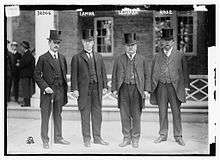Frederick William Lehmann
| Frederick W. Lehmann | |
|---|---|
 | |
| Born |
February 28, 1853 Prussia |
| Died | September 12, 1931 (aged 78) |
| Nationality | American |
| Occupation | Lawyer |

Frederick William Lehmann (February 28, 1853 – September 12, 1931) was a prominent American lawyer, statesman, United States Solicitor General, and rare book collector.
Biography
He was born February 28, 1853 in Prussia. His father Friedrich Wilhelm Lehmann emigrated to Cincinnati, Ohio, when Frederick was two, where he ruled the family with an iron hand. His mother Sophia died young.
At age 10, Frederick ran away from home forever. As a vagabond, selling newspapers, working on farms, and herding sheep, he wandered across the Midwest, rarely going to school. In his teens, at the urging of his fellow sheep men, he took the stump for presidential candidate Horace Greeley and gave his first political speech.
At 17 he worked as a farm-hand for Judge Epenetus Sears of Tabor, Iowa. Sears was impressed with the boy's ability and sent him to Tabor College, where he graduated in 1873. After "reading law" in his benefactor's office, Lehmann practiced in Tabor, Sidney, Nebraska City, and Des Moines, Iowa. He married Nora Stark of Indianola on December 23, 1879, and he represented the Wabash Railroad.
A noted orator, he was active in Iowa politics, including the election of Governor Horace Boies. In 1890 he moved with his family to St. Louis, Missouri and continued to represent the Wabash while building a general law practice. In 1908 he was elected president of the American Bar Association and served twice.
President William Howard Taft named Lehmann as United States Solicitor General in 1910. In the Supreme Court of the United States Lehmann established the right to tax corporation incomes. He considered national bank affiliates to be illegal. About Lehmann's oral arguments, Justice Louis Brandeis said: "He was so eloquent, you hated to rule against Lehmann; you felt as though you were ruling against God."
In 1912 he returned to practice law in St. Louis with his sons.
In 1914, however, he and Justice Joseph Rucker Lamar represented the United States at the ABC Powers Conference in which Argentina, Brazil, and Chile mediated between the United States and Mexico on the Veracruz Incident.[1]
Cases in his private practice established the right of the Associated Press to news as intellectual property, and he secured the Telephone Company's right to valuation on reproduction cost less depreciation.
In 1918 he became counsel for the Railway Wage Commission. He supported the forced separation of investment banks, commercial banks and brokerages (a policy later implemented in the Glass–Steagall Act of 1933) quoting: "One man cannot serve two masters." He also vigorously opposed Prohibition.
Representing the U. S. government in the Supreme Court, he would "confess judgment", a practice in which the Solicitor General admits that the government has been wrong all along and just drops the case even when supported by a lower court's prior decision. Inscribed in the office rotunda of the Attorney General is Lehmann's famous saying: "The United States wins its point whenever justice is done its citizens in the courts."
Frederick Lehmann always refused to run for public office, especially at a party convention of the breakaway Gold Democrats (opposed to the Free Silver candidate William Jennings Bryan) in St. Louis which he chaired (being foreign-born, he could not run for President anyway), and he declined judgeships. In politics he was generally a Democrat, if sometimes a Gold Democrat. In 1909 he drafted the charter by which the City of St. Louis is still run today.
He was a founder of the St. Louis Art Museum and the State Historical Society of Missouri, president of the St. Louis Public Library, and a director of the St. Louis World's Fair (Louisiana Purchase Exposition) of 1904, in which he was host of the Universal Congress of Jurists and Lawyers. He was a bibliophile and he collected rare first editions of Charles Dickens, Robert Burns and others, and artworks of Aubrey Beardsley, George Cruikshank and Thomas Rowlandson. He and industrialist William K. Bixby started the Burns Society; he was twice president of the University Club of St. Louis. He had a remarkable (possibly eidetic) memory—when writer Henry James visited his house, Lehmann could recite whole works that James himself had written but forgotten. For most his life Lehmann was in demand as a public speaker, which he thoroughly enjoyed. His published works included: John Marshall (1901); The Lawyer in American History (1906); Abraham Lincoln (1908); Conservatism in Legal Procedure (1909); Prohibition (1910); and The Law and the Newspaper (1917).
In old age he auctioned off his rare book collections. He died September 12, 1931, aged 78, survived by his wife and three sons, lawyers Sears Lehmann, Frederick W. Lehmann, Jr., and John Stark Lehmann. He was buried in Bellefontaine Cemetery in St. Louis.
Legacy
Three special collections at Olin Library, Washington University in St. Louis, include a selection of Lehmann's legal papers (including his time as Solicitor General), a collection of historic manuscript letters of notable people, and rare editions of works of Robert Burns and others. There is also a Frederick Lehmann Autograph Collection at the Missouri Historical Society, St. Louis.
Frederick W. Lehmann's house at No. 10 Benton Place in St. Louis is now preserved as the "Lehmann House" Bed and Breakfast.
References
- ↑ "Lehmann To Fight At Claflin Meeting". New York Times. July 24, 1914. Retrieved 2014-01-02.
Frederick V. Lehmann, who was one of the United States Commissioners at the Mexican peace conference at Niagara Falls ...
| Legal offices | ||
|---|---|---|
| Preceded by Lloyd Wheaton Bowers |
Solicitor General 1910–1912 |
Succeeded by William Marshall Bullitt |
